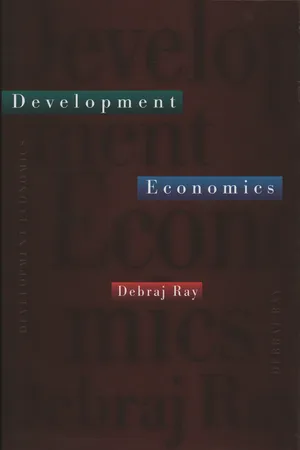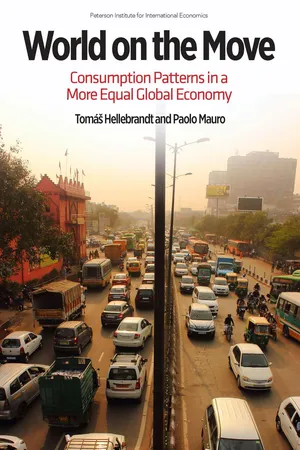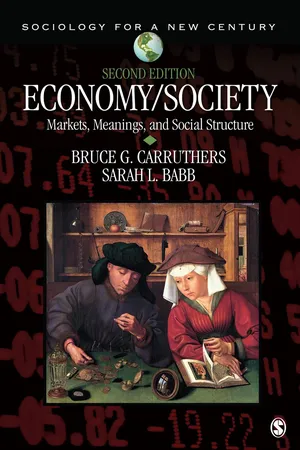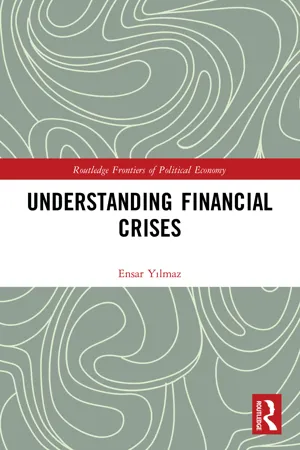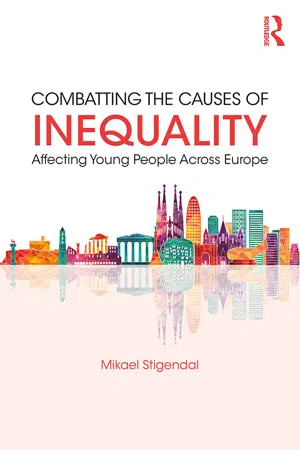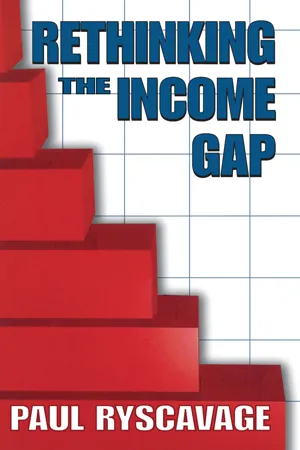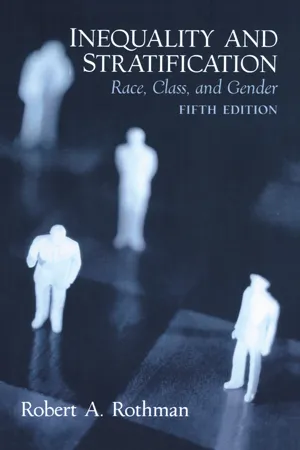Economics
Income Inequality
Income inequality refers to the unequal distribution of income among individuals or households within a society. It is often measured using metrics such as the Gini coefficient, which quantifies the disparity in income distribution. High levels of income inequality can have social and economic implications, including reduced social mobility and potential negative effects on overall economic growth.
Written by Perlego with AI-assistance
Related key terms
11 Key excerpts on "Income Inequality"
- eBook - ePub
- Debraj Ray(Author)
- 1998(Publication Date)
- Princeton University Press(Publisher)
Chapter 7 , we will examine, both at an empirical and theoretical level, how inequality interacts with other economic variables, such as aggregate income and the growth of aggregate income.6.2. What is economic inequality?
6.2.1. The context
At the level of philosophy, the notion of inequality can dissolve into an endless sequence of semantic issues. Ultimately, economic inequality is the fundamental disparity that permits one individual certain material choices, while denying another individual those very same choices. From this basic starting point begins a tree with many branches. João and José might both earn the same amount of money, but João may be physically handicapped while José isn’t. John is richer than James, but John lives in a country that denies him many freedoms, such as the right to vote or travel freely. Shyamali earned more than Sheila did until they were both forty; thereafter Sheila did. These simple examples suggest the obvious: economic inequality is a slippery concept and is intimately linked to concepts such as lifetimes, personal capabilities, and political freedoms.2Nevertheless, this is no reason to throw up our hands and say that no meaningful comparisons are possible. Disparities in personal income and wealth at any point of time, narrow though they may be in relation to the broader issues of freedom and capabilities, mean something . This statement is even more true when studying economic disparities within a country, because some of the broader issues can be regarded (at least approximately so) as affecting everyone in the same way. It is in this spirit that we study income and wealth inequalities: not because they stand for all differences, but because they represent an important component of those differences.6.2.2. Economic inequality: Preliminary observations
With the preceding qualifications in mind, let us turn to economic - eBook - ePub
Economic Growth
International Edition
- David N. Weil(Author)
- 2016(Publication Date)
- Routledge(Publisher)
Chapter 12 , reducing inequality is frequently one of the most important goals of government economic policy. Some policies may achieve the twin goals of reducing Income Inequality and raising economic growth. A good example of such a policy is the public provision of education. In other cases, however, the goals of maximizing economic growth and reducing Income Inequality are in conflict. In this chapter we discuss one such case in detail—the redistribution of income through taxation.Finally, Income Inequality within a country is, for residents of a country itself, often a more salient issue than differences in income among countries. A poor person in the United States is probably more aware of where he or she stands in relation to rich people in the United States than he or she is of her status relative to people in countries that are much poorer than the United States. To the extent that people derive their happiness not from the absolute level of their consumption but from how their consumption compares with that of the people around them, Income Inequality within a country may be more important than differences in income among countries. This is a topic to which we will return in Chapter 17 .In this chapter we begin by discussing how Income Inequality is measured and how movements in inequality have historically been related to economic growth. We then look at the determination of inequality itself: what factors influence it and what mechanisms cause the degree of inequality to change over time. We next examine—both theoretically and empirically—how Income Inequality affects economic growth. Finally, we consider economic mobility, a concept that is closely related to Income Inequality.Income Inequality: THE FACTS13.1Thus far, most of our measurements have been concerned with country averages - eBook - ePub
- Nan de Graaf, Dingeman Wiertz(Authors)
- 2019(Publication Date)
- Routledge(Publisher)
7 Economic inequality Chapter overview We begin this chapter with a brief discussion of why economic inequality is problematic, followed by a review of inequality trends around the world. Whereas Income Inequality has increased within most countries since the 1970s, global Income Inequality has remained stable during most of the twentieth century and has started to decline in the last few decades. This latter trend is driven by reductions in the inequality between countries, and global poverty has dropped accordingly. However, extreme poverty remains persistent in many parts of the world, and we discuss several theories to explain why this is the case. In addition, we examine what is happening in terms of income and wealth at the other end of the distribution, to the so-called “top one percent”. Next, we consider the relationships between inequality, national income, and economic growth. We demonstrate that it is in this regard important to distinguish between comparisons of different countries at a single point in time versus comparisons within countries over time. We also address the impact of inequality on the well-being of individuals and society more generally, concentrating on the influence of inequality on health as well as intergenerational social mobility. Economic inequality as a problem To what extent one regards a certain level of inequality as problematic and cause for state intervention will depend on which of the three political ideologies discussed in Chapter 1 one adheres to: socialism, liberalism, or conservatism. In general, liberals will be most tolerant of economic inequality and socialists the least. The former firmly believe in the value of the market as allocator of resources and distributor of wealth, while the latter often regard market outcomes as unsatisfactory. They therefore call on the state to step in and redistribute resources in order to achieve a more equal distribution - eBook - ePub
World on the Move
Consumption Patterns in a More Equal Global Economy
- Paolo Mauro, Tomas Hellebrandt, Jan Zilinsky(Authors)
- 2016(Publication Date)
Because household surveys tend to underrepresent the richest households, they may fail to fully capture the rising share of income going to the very top. When survey data are adjusted for underreporting of selfemployment income and undersampling of rich households, recent trends in inequality remain mixed. Out of 102 countries with at least two data points after 2000 that are more than five years apart, 47 saw a reduction in inequality of more than one Gini point in that interval, 39 experienced an increase of more than one point, and the remaining 16 experienced changes of less than one point (in either direction).Relationship between Inequality and DevelopmentWhen thinking about future developments in a growing world economy, it is important to consider the possibility that distributional patterns in advanced economies on the one hand and emerging-market economies on the other will differ. Social and economic changes are more rapid and disruptive in the latter group, which may be reflected in the distribution of living standards there.Historically, a multitude of factors has affected the distribution of income (or consumption) within countries. These factors vary across countries and over time. Studies seeking to unveil potential determinants of changes in within-country inequality have focused on changes in GDP, using two approaches.The first, simpler, approach examines whether growth is good for the poor. It analyzes the empirical association between growth in real per capita GDP and the share of GDP accruing to the bottom of the distribution. This research finds no significant evidence of systematic effects of economic growth on the distribution of incomes. In their study of 118 countries over the past four decades, David Dollar, Tatjana Kleineberg, and Aart Kraay (2013) find that changes in the share of income accruing to the bottom two quintiles in individual countries are generally small and uncorrelated with changes in average income. In a similar panel of countries, they find that changes in overall income are the primary driver of changes in social welfare (measured by various measures of overall income and inequality); changes in inequality play a relatively minor role (Dollar, Kleineberg, and Kraay 2014 ).4 - eBook - ePub
Economy/Society
Markets, Meanings, and Social Structure
- Bruce G. Carruthers, Sarah Louise Babb(Authors)
- 2012(Publication Date)
- SAGE Publications, Inc(Publisher)
Wealth, on the other hand, consists of the resources an individual already possesses rather than a flow received over a time period. Examples of wealth include household items such as cars and DVD players but also more substantial resources such as real estate, savings accounts, stocks, and bonds. Modern industrial societies are all characterized by inequalities in both income and wealth: Some people have more, and other people have less.Although income and wealth are the economic resources most commonly studied by social scientists, there are other important resources, such as access to credit and competitive prices. Some people are able to get loans so they can buy things that they could not otherwise afford (such as houses) and others are not. Similarly, some people are able to purchase the things they need at more affordable prices than are available to other people. Access to these two sorts of socioeconomic resources often varies by race and gender—an issue we return to below in the section headed “Race, Gender, and Inequality.”Income Inequality
Inequalities of income are not universal and unchanging; rather, they vary a great deal across time and space. To look at how inequality differs in different countries, or how it has changed over time, we need a way to measure it. One simple way to measure Income Inequality is to divide the population of income earners into fifths (or quintiles) and then calculate what proportion of total income each fifth gets. Thus, we consider how much income the top (or richest) fifth receives compared with the second fifth or with the bottom (poorest) fifth. If we think of the economy as a pie, looking at income share by quintiles tells us how big a piece of the pie each group is getting. In a society with absolute income equality, every fifth would receive exactly one-fifth of the total income. In a society with extreme inequality, the top fifth would get all the income, and the bottom four-fifths would get nothing. Real societies, of course, fall somewhere between these two extremes. - eBook - ePub
- Ensar Y?lmaz(Author)
- 2020(Publication Date)
- Routledge(Publisher)
4Income Inequality
4.1 IntroductionThe distribution of income and wealth has been a significant matter in economics and the social sphere since the 18th century. There has been a long tradition in economics that emphasizes the effects of distribution on economic processes, seen in the books of Smith, Ricardo, Marx, and Keynes. Economists, especially those belonging to Marxist and Post-Keynesian schools, continue to explore the implications of Income Inequality.However, interest in issues of income distribution declined post-Second World War; this was mainly due to the fall in inequality during this period. Hence, mainstream economists have not given an important role to income distributional considerations in explaining financial crises. As Atkinson and Morelli (2015) succinctly pointed out, prominent scholars such as Kindleberger and Aliber (2011), Krugman (2009), and Reinhart and Rogoff (2009), do not even mention income distribution in their studies. Moreover, in a relatively recent study, Robert Shiller’s The Subprime Solution (2008), again inequality does not appear. The US Financial Crisis Inquiry Commission, set up in 2009 to investigate the global crisis did not refer to inequality at all. Thus, several economists either disregarded the macroeconomic effects of inequality or regarded it positively due to its creating the opportunity to expand credit to those who demand it.Recently many researchers have started to point out that Income Inequality is one of the most important problems of our era. Inequality has significantly increased in many countries over the last few decades. Some researchers blame Income Inequality for several social ills. Richard Wilkinson and Kate Pickett claim that if the UK halved inequality,“murder rates would halve, mental illness would reduce by two thirds, obesity would halve, imprisonment would reduce by 80%, teen births would reduce by 80%, and levels of trust would increase by 85%”. - eBook - ePub
Capitalism in the UK
A Perspective from Marxist Political Economy
- Mike Campbell(Author)
- 2023(Publication Date)
- Routledge(Publisher)
We have already outlined in a previous section a theory of inequality but we give more flesh to this theory now by analysing the influence of different forms of income on inequality. There are basically three sources of income: income derived from ownership of assets and property; income derived from the labour market; and income derived from the state in the form of benefits. We treat each of these in turn.Income derived from ownership of assets, from wealth, often referred to aptly as ‘unearned income’ is the major factor determining Income Inequality. We have already seen in the section on the distribution of wealth that it is even more unequally distributed than the distribution of income, and that income from wealth is likely to be even more unequally distributed than the distribution of wealth itself, because of the different structure of assets held by the most wealthy compared to those with little wealth. Much of the wealth of the bulk of the population is held in the form of owner occupied houses, consumer durables and other personal assets which do not yield income, and much of the rest is in a form that yields lower incomes than those of the more wealthy groups in society, whose assets are constituted largely by ownership of land and the means of production. Only 20% of tax payers receive any income from wealth at all, 8% receive about 75% of this income whilst a mere 1% have 33% of it – receiving the same amount that, after tax, the poorest 30% of the population receive in all as their income! This is of course additional to the capital gains that arise from holding wealth in the form of stocks and shares and which can be realised through their sale. The contribution of ‘unearned’ income then to Income Inequality is of paramount importance. If the income yielded from private property were distributed equally to every ‘married couple’ it would be equivalent to 25% of gross average incomes. Such redistribution would of course fundamentally threaten capitalism itself.The second source of income is ‘earned income’, wages and salaries, income derived from selling one’s labour power to others. Essentially the labour market operates on similar principles to other markets in a capitalist economy. Labour power is a commodity like any other to be bought and sold and its price, the wage, is its exchange value expressed in money terms. It is the amount of money a capitalist must pay to ‘persuade’ workers to work during which process they perform surplus labour for the capitalist thus producing surplus value. Whilst the relations between workers and capitalists seem free and equal at one level, the level of markets, at another level, that of production, they are coercive and unequal. Labour power once purchased is used, controlled and dominated by capital. Thus wages reflect the relative power of capital and labour at any particular moment in time or any particular situation. This balance of power whilst being fundamentally loaded in favour of capital, may shift somewhat under the operation of market forces as excess demand for labour power develops, in general or in particular, and the industrial reserve army, the extent of the excess supply of labour power, shrinks. This has the effect of reducing the degree of competition for jobs between workers and increasing the competition between capitalists for workers and may therefore cause wages to rise. Of course, labour is not passive in this unequal relationship at work, and exploitation is resisted through struggles in bargaining over wages, conditions of work and so on. This struggle is a permanent feature of relations of production in capitalism. There is a continuous conflict over the distribution of surplus value between capital and labour, for though the former has first claim to it, it is possible for workers through their collective organisations, depending on their strength, organisation and militancy, to claim some of the fruits of increased ‘productivity’. However in situations where productivity is not increasing, or increasing slowly, successful attempts to increase wages beyond a certain point may threaten the accumulation process as the rate of surplus value falls. Hence workers are often faced with the choice of moderating wage claims or facing unemployment caused by a break in the accumulation process. Such are the ‘choices’ of a capitalist economy. - Mikael Stigendal(Author)
- 2018(Publication Date)
- Routledge(Publisher)
2What is inequality?
Inequality is “one of the most pressing issues of the day”, Michael Burawoy, president of the International Sociological Association, said in his welcome address to the World Congress of Sociology in 2014 with the title “Facing an unequal world”. The World Economic Forum, in its Global Risks Report 2017, ranks inequality first among the risks to the global economy and the underlying trends that will determine the shape of the world in the next decade.As the OECD Secretary General Angel Gurria wrote in his editorial to the report Divided we stand. Why inequality keeps rising (OECD, 2011: 17), “inequality has become a universal concern, among both policy makers and societies at large”. He then went on and mentioned the huge difference in incomes between the rich and poor. That is obviously an inequality, about which scholars like Anthony Atkinson, Branco Milanovic and Thomas Piketty (2014) have vastly expanded the empirical knowledge. Corresponding achievements have been made by epidemiologists like in particular Michael Marmot (2015) and Richard Wilkinson & Kate Picket (2009), focusing on inequality in terms of health (WHO, 2008). What have these inequalities in common? What makes them inequalities? What else is inequality? What should we mean by inequality?First of all, inequality is a word; in itself it also has certain properties. Something exists which we have decided to call inequality and the name of it puts us on a certain track to an understanding of it. Similarly, the word poverty tends to direct us, but more narrowly, to focus on the poor. There is nothing inevitable in the word ‘poverty’ which makes us become interested in the rich. To be sure, our wider perspective may certainly motivate such an interest, but the single word poverty does not. You need to be thoughtful and as Tawney described it thoughtfully in the early 20th century “what thoughtful rich people call the problem of poverty, thoughtful poor people call with equal justice a problem of riches” (from Sayer, 2015: 29). Indeed, this lack of interest in the problem of riches is confirmed by the major part of research which has occupied itself solely with poverty and the poor. We could say that the word poverty has a potential, which, when we use and thus actualise it, tends to direct our attention towards the poor, although it does not constrain us to it.- eBook - ePub
Rethinking the Income Gap
The Second Middle Class Revolution
- Paul Ryscavage(Author)
- 2017(Publication Date)
- Routledge(Publisher)
4The Income Inequality–Economic Fairness “Disconnect”I think that egalitarian ethical views are so deeply imbedded in culture that we often find it embarrassing to discuss the issue, and even to question the validity of that position.—William H. PooleThe reason there is not a revolution in this country today over the income gap but only an income gap muddle is because of, the Income Inequality–economic fairness “disconnect” that took place over the last few decades.Changes in Income Inequality and economic fairness have been traditionally thought to be inversely related. That is, as a society’s income gap grows wider, the general level of economic fairness declines. In the parlance of the street, this translates to, “the rich are getting richer and the poor are getting poorer!”It should be clear by now that the hypothesis underlying the message of this book is that the traditional relationship between inequality and fairness broke down in the United States. A “disconnect” developed. For many Americans, this disconnect has not been fully understood nor explained to them in a clear and concise way.Much of our mainstream media, although never explicitly saying so, believe that the relationship between growing Income Inequality and declining economic fairness is still very much alive. Simply pick up a copy of the morning newspaper or watch the evening news and read the stories relating to the economic conditions of segments of our society and there, between the lines (and sometimes not between the lines), you will find the traditional relationship. Whether it is a story relating to the under-funded pension plans of retirees or the low-wage workers without health benefits, this relationship is lurking in the shadows. And as discussed earlier, it always conjures up victims and culprits. - eBook - ePub
Inequality and Stratification
Race, Class, and Gender
- Robert A. Rothman(Author)
- 2015(Publication Date)
- Routledge(Publisher)
There are two fundamental approaches to measuring economic inequality in a society. Annual income counts the amount of money a family earns in a year from wages, salaries, and investments, and net worth includes the total value of all forms of wealth and possessions. Both confirm the existence of a wide gulf between the privileged and the disadvantaged in the United States and other industrial nations.Annual Income
One of the most basic ways of visualizing the scope of financial inequality is to focus on the total annual income of individuals and families. This measure takes into account wages and salaries, rental income, investments in stocks and bonds, and other direct sources of income. It is basically the amount that the Internal Revenue Service is interested in every April 15th. Households are the unit of analysis in calculating income to accommodate families with multiple earners and dependent children. In 2001, the median household income in the United States was $42,228 (DeNavas-Walt and Cleveland, 2002 ). The overall trend has been upward, but always interrupted during reversionary periods. As shown in Exhibit 5.1 , there are striking income differences among racial and ethnic groups with African Americans and Hispanics falling thousands of dollars below the median, and whites and Asian Americans above it.Exhibit 5.1 Median Household Income by Race and Hispanic OriginSource: Carmen DeNavas-Walt and Robert W. Cleveland. Money Income in the United States: 2001. Current Population Reports P60–218.Washington, DC: U.S. Government Printing Office, 2002. Figure 1.Median household incomes reveal only part of the income picture. Discrepancies among income levels can be dramatically highlighted by dividing the population into quintiles (fifths) and computing the share of total income earned by each of the five income groups in an earlier year, as shown in Exhibit 5.2 - eBook - ePub
The Rich and the Poor in Modern Europe, 1890-2020
A Historian's Response to Recent Debates among Economists
- Hartmut Kaelble(Author)
- 2023(Publication Date)
- Berghahn Books(Publisher)
31When it comes to the very poor, hundreds of thousands of refugees and unregistered migrants, the Gini coefficient is quite unreliable, as these groups generally do not appear in data relating to income distribution. Instead, they appear in income calculations only when they have gained legal status as immigrants, as will be discussed in the context of the next subsection. This means that trends since the turn of the century offer a somewhat different picture. According to the Gini coefficient, incomes did not become exacerbated only within the broad range of middle of incomes. Income disparities sharpened at the top and the lowest end. Top incomes grew further, whereas the lowest 10 percent lost out. The new social inequalities that began to emerge from the beginning of the twenty-first century, marked as it was by huge top salaries, on the one hand, and more abject poverty, on the other, are slowly becoming more visible also in respect to their social and political consequences.POVERTY
Poverty saw a renewed increase from the late 1970s and the 1980s onward. Social scientists and public reports on poverty levels issued a warning at the time that poverty was again on the increase. To be sure, absolute poverty, the number of people who lived below the existential minimum, rose very rarely. But relative poverty was again rising: families who fell below the general standard of income, housing, education, health care, and participation in cultural offerings. When it came to their economic and social situation a growing number of the poor was therefore left behind by the majority of the population. However, experts continue to disagree how we can measure poverty, which groups were only temporarily poor, and which groups remained stuck in the cycle of poverty. A frequently used contemporary measure is that whoever receives no more than 60 or 50 percent of the median income is deemed to live in poverty. But there are two reasons why this yardstick is falling short. To begin with, it leaves out key factors of poverty, such as education and health. Nor does it consider the level of participation in communal life and to what extent a life in poverty is temporary or more permanent without any hope of an improvement. What is decisive, though, is that since the 1980s all indicators of poverty in Europe have pointed toward a deterioration of conditions.32
Index pages curate the most relevant extracts from our library of academic textbooks. They’ve been created using an in-house natural language model (NLM), each adding context and meaning to key research topics.
